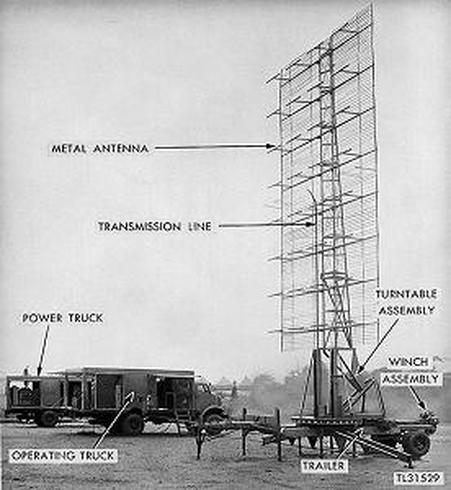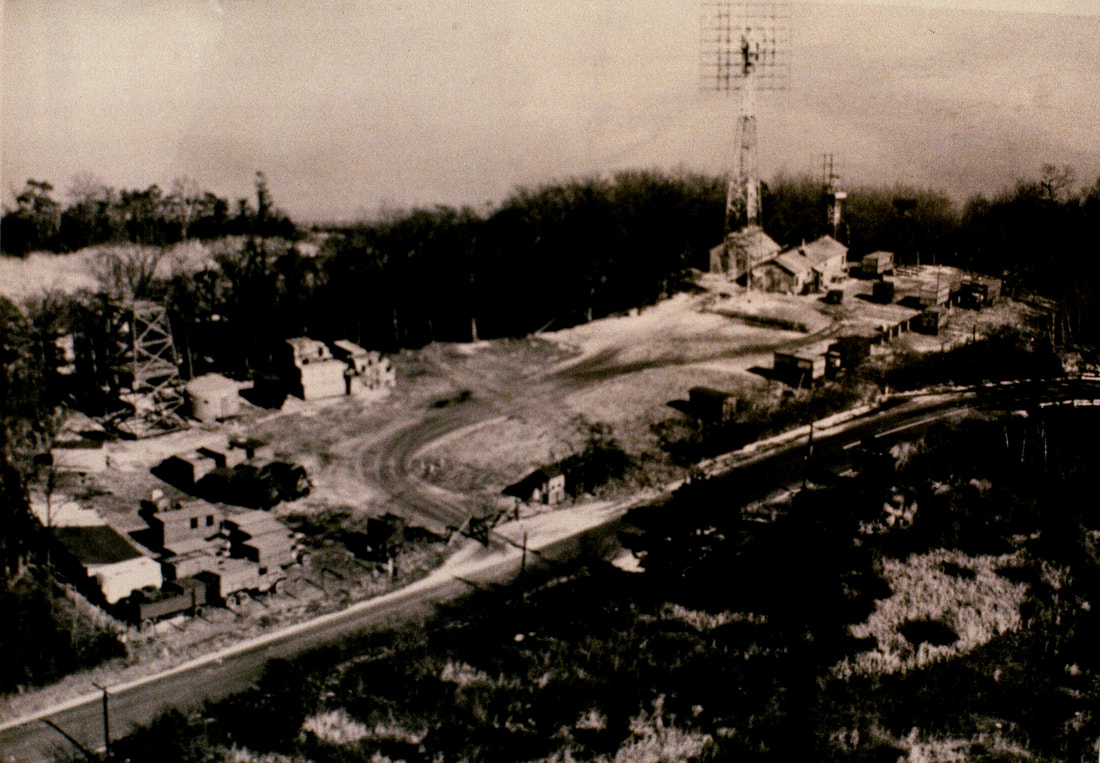Not everyone, however, had shared my mother’s implicit faith that Project Diana would succeed. Radar had more than demonstrated its utility during World War II in locating enemy aircraft and submarines, but - hit the moon? Earlier unsuccessful efforts had convinced many that asking radio waves to pierce the ionosphere, hit a designated object in space, and then return back through earth’s atmosphere to the point of origin was expecting too much of the technology. Indeed, the standard method for measuring the distance to the ionosphere at that time was “pulse ranging” - that is, bouncing radio waves off the reflective surface of the ionosphere and timing their return, not passing through it.
Only a group of optimistic visionaries would attempt such a feat. Only a group of engineers would have the practical know-how to accomplish it.
This effort was the brainchild of Lt Col John "Jack" DeWitt, head of the Evans Signal Laboratory at Camp Evans in Wall, NJ. Right after the Japanese surrender in September of 1945, DeWitt was assigned the task of developing radars capable of detecting missiles from the Soviet Union. Since no missiles were available for a test,
DeWitt decided the moon could serve as a stand-in - and incidentally allow him to carry out a project he had dreamed of since long before World War II. Like my mother and unlike the skeptics, he was quite confident (despite a previous failure of his own several years earlier) that it could be done, if done right.
If ever there was a monument to American ingenuity, it is surely Project Diana. The approach, as I mentioned in an earlier post, was to work rapidly and intensively, use and modify materials already on hand, and then test, test, test. “Materials already on hand” was the watchword. No attempt was made to design any of the main components for the project from scratch, and little if anything new was purchased to make it happen. The transmitter, the receiver, and the antenna all represented novel applications and redesigns of equipment they had used before.
These three elements were interdependent and had to work together as one for the project to succeed. Arguably the most critical, however, was the antenna, since the failure of previous attempts was attributable in large measure to insufficient sensitivity of the receiver antenna.
Then, in 1938, shaken by the discovery in their midst of a Nazi spy named Guenther Gustave Maria Rumrich, a Chicago-born German whose friendly curiosity had enabled him to infiltrate the radar research program alarmingly easily, the Army decided to increase security and reduce accessibility by moving the operation from Fort Monmouth to Fort Hancock.
It was at Fort Hancock that the legendary SCR-270/271, capable of detecting bombers 150 miles away, was developed under the leadership of Dr. Harold Zahl. Among other important innovations, this system featured a common antenna for both transmitting and receiving, made possible by a gas-discharge device called a duplexer invented by Zahl. The SCR-270 was a mobile unit; the SCR-271 was a fixed, tower-mounted version that differed mainly in having an antenna with a somewhat higher resolution.
My father was recruited as a young engineer to the Army's radar research program at Fort Hancock in early 1941, in the Radio Position Finding section. He participated in the development of the SCR-270/271 radar and continued to work on modifying and improving it throughout the War. Many years later, he wrote of this radar that it was "still the Old Faithful, coming through where more modern and more advertised sets have become unavailable."
So the Army purchased the old Marconi site in Belmar from King’s College and rechristened it Camp Evans. Piecemeal, the radar research program was evacuated from Fort Hancock. Pearl Harbor hastened the transfer, and by 1942 the move to Camp Evans was complete.
With the acquisition of the Camp Evans site, the Signal Corps inherited a rich history of antenna development. During World War I, the Navy had assumed control of the property, and although Marconi’s famous 400-foot wireless towers were used for the dispatch of important messages - indeed, historians dubbed World War I the “wireless war” - breakthroughs in reducing radio static achieved by a resident Canadian scientist named Roy Weagant enabled replacement of these ungainly structures by safer and cheaper if more ho-hum 30-foot antennas. This news was kept under wraps until after the War; “The End of the Giant Towers,” proclaimed contemporary headlines. All of them were gone by 1925.
The arrival of the Army and the entry of the US into World War II transformed the site into a major center for radar research. In addition to newer systems (some involving testing of conceptual designs developed at the MIT Rad Lab), refinement and stepped-up production of the "Old Faithful" SCR-270/271 continued throughout the War - turning Building 37 into a veritable antenna factory as bedspring-type array antennas ranging in length from 2 to 30 feet were assembled for installation on trailers to be used in remote locations. One such SCR-270 radar provided an early warning of incoming Japanese aircraft at Pearl Harbor - though in one of history’s most egregious command and control failures, the information was initially misinterpreted by the Operator and subsequently discounted by the Commanding Officer on duty.
Early on, DeWitt decided to use as a starting point a crystal-controlled FM transmitter/receiver specially designed for the Signal Corps by Major Edwin H. Armstrong, the "father of FM radio," by modifying an SCR-271. This set had features that could address two important problems:
1) Due to the relative velocities of the earth and moon, the frequency of the returning echo differed from the transmitted signal (a phenomenon known as Doppler shift) by as much as 300Hz, a number that was constantly changing depending earth's rotation and moon's orbital path. DeWitt called on the Theoretical Studies Group for these elegant calculations, which were done by the mathematician Walter McAfee.) The Armstrong radio was capable of being fine-tuned to the exact frequency required to compensate for the Doppler shift at a given point in time.
2) Signals bounced off an object 238,000 miles from earth would take much longer to echo and be much too weak to be detected by receiving antennas then in use. As noted, this was a problem that had bedeviled previous attempts to shoot the moon. To amplify the incoming signal, it was decided to generate a much longer pulse that would be easier for the receiving antenna to detect. The Armstrong radio was one of the few existing sets capable of generating such a long pulse.
The long pulse, while solving one problem, created another, since there was no antenna on site ready to receive such a signal. To come up with a solution, DeWitt called on the Antenna Design Section at Camp Evans. Two prominent antenna specialists, one the section head, designed a novel system using a quarter-wave step-up transformers. This approach failed to work, however, even after extensive efforts to tweak the transmitter.
DeWitt then turned to his own little group of engineers, who came up with the inspired solution of positioning two SCR-271 stationary radars side-by-side to create an enormous (40x40 ft) double bedspring antenna consisting of a 8x8 array of half-wave dipoles in front of a reflector that further enhanced the 111.5 MHz signals. Who was the first to propose that approach will probably never be known, but given my father's long experience and intimate familiarity with the SCR-271, his leadership role on the team, and his general approach to problem-solving, it wouldn't surprise me if the credit belonged to him. In any event, translating the idea into reality was undoubtedly easier said than done, but engineers from the Mechanical Design Center rose to the occasion and succeeded in assembling the Diana Bedspring. (Unfortunately, engineering specifications were destroyed by the Army in 1971, so our knowledge of the design details remains sketchy.)
This whole contraption - there is no other word for it - was mounted atop a 100-ft reinforced tower in the northeast corner of Camp Evans. The heavy and ungainly antenna could not be tilted, it could only be rotated in azimuth; so moonshots could only be attempted twice a day, usually at moonrise but occasionally at moonset, during the 40-minute window open when the moon passed through the 15 degree wide beam of the antenna pattern.
The replacement antenna was a 50-foot dish created by the Signal Corps, using the frame of a captured Nazi Wurzburg Reise radar, to serve as our first satellite tracking antenna. In honor of its predecessor, it was dubbed the “Diana Dish.” In 1957, when the Soviets stole a march on the US by launching their Sputnik satellite, the Diana Dish was joined by a companion 60-foot dish named the “Space Sentry.” In 1960, control of space research was transferred to a new civilian agency, NASA, which continued the weather observation research already underway at the Diana site and proudly broadcast the first televised images of cloud movements from space.
The Diana Dish has joined the Diana Bedspring in the dustbin of history, but the Space Sentry was gifted by the Army to InfoAge, which has refurbished it for scientific and educational purposes as part of a larger effort to restore and preserve the Diana site. On January 10, 2015, a local amateur radio club celebrated the 70th anniversary of the Project Diana experiment by using the Space Sentry to make a series of Earth-Moon-Earth contacts.
To accomplish this feat, EME enthusiasts need to erect antennas that by amateur radio standards are often large enough to jangle the nerves of Property Owners’ Associations and perhaps violate the aesthetic sensibilities of their XYLs (ham-speak for ”ex young ladies” - that is, ahem, their wives). By Project Diana standards, however, most modern EME antennas are mere minikins and some are even portable.



 RSS Feed
RSS Feed